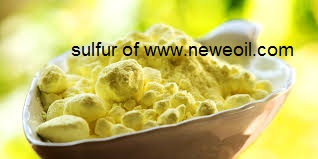
Sulfur (S)
, nonmetallic chemical element belonging to the oxygen group (Group 16 [VIa] of the periodic table), one of the most reactive of the elements. Pure sulfur is a tasteless, odourless, brittle solid that is pale yellow in colour, a poor conductor of electricity, and insoluble in water. It reacts with all metals except gold and platinum, forming sulfides; it also forms compounds with several nonmetallic elements. Millions of tons of sulfur are produced each year, mostly for the manufacture of sulfuric acid, which is widely used in industry.In cosmic abundance, sulfur ranks ninth among the elements, accounting for only one atom of every 20,000–30,000.
To buy and order all kinds of sulfur produced in Iran and the countries of the Caspian Sea such as Turkmenistan, Kazakhstan, Uzbekistan and Russia, send a message or call to the following number on WhatsApp.
00989133314524
Engineer Jalali
گوگرد (S)، عنصر شیمیایی غیرفلزی متعلق به گروه اکسیژن (گروه 16 [VIa] جدول تناوبی)، یکی از واکنش پذیرترین عناصر. گوگرد خالص یک جامد بی مزه، بی بو و شکننده است که به رنگ زرد کم رنگ، رسانای ضعیف الکتریسیته و نامحلول در آب است. با تمام فلزات به جز طلا و پلاتین واکنش می دهد و سولفید تشکیل می دهد. همچنین ترکیباتی را با چندین عنصر غیرفلزی تشکیل می دهد. سالانه میلیون ها تن گوگرد تولید می شود که بیشتر برای تولید اسید سولفوریک است که به طور گسترده در صنعت استفاده می شود.
برای خرید و سفارش انواع گوگرد محصول ایران و کشورهای حوزه دریای خزر مثل ترکمنستان ،قزاقستان ،ازبکستان و روسیه به شماره زیر در واتساپ پیام بدهید و یا تماس بگیرید
00989133314524
مهندس جلالی
Sulfur occurs in the uncombined state as well as in combination with other elements in rocks and minerals that are widely distributed, although it is classified among the minor constituents of Earth’s crust, in which its proportion is estimated to be between 0.03 and 0.06 percent. On the basis of the finding that certain meteorites contain about 12 percent sulfur, it has been suggested that deeper layers of Earth contain a much larger proportion. Seawater contains about 0.09 percent sulfur in the form of sulfate. In underground deposits of very pure sulfur that are present in domelike geologic structures, the sulfur is believed to have been formed by the action of bacteria upon the mineral anhydrite, in which sulfur is combined with oxygen and calcium. Deposits of sulfur in volcanic regions probably originated from gaseous hydrogen sulfide generated below the surface of Earth and transformed into sulfur by reaction with the oxygen in the air
| atomic number | 16 |
|---|---|
| atomic weight | 32.064 |
| melting point | |
| rhombic | 112.8 °C (235 °F) |
| monoclinic | 119 °C (246 °F) |
| boiling point | 444.6 °C (832 °F) |
| density (at 20 °C [68 °F]) | |
| rhombic | 2.07 grams/cm3 |
| monoclinic | 1.96 grams/cm3 |
| oxidation states | −2, +4, +6 |
| electron configuration | 1s22s22p63s23p4 |
To buy and order all kinds of sulfur produced in Iran and the countries of the Caspian Sea such as Turkmenistan, Kazakhstan, Uzbekistan and Russia, send a message or call to the following number on WhatsApp.
00989133314524
Engineer Jalali
در فراوانی کیهانی، گوگرد در بین عناصر در رتبه نهم قرار دارد و از هر 20000 تا 30000 تنها یک اتم را تشکیل می دهد. گوگرد در حالت ترکیب نشده و همچنین در ترکیب با عناصر دیگر در سنگها و کانیهایی که به طور گسترده پراکنده شدهاند، وجود دارد، اگرچه در میان اجزای کوچک پوسته زمین طبقهبندی میشود که در آن نسبت آن بین 0.03 تا 0.06 درصد تخمین زده میشود. بر اساس این یافته ها که شهاب سنگ های خاص حاوی حدود 12 درصد گوگرد هستند، پیشنهاد شده است که لایه های عمیق تر زمین دارای نسبت بسیار بیشتری هستند. آب دریا حاوی حدود 0.09 درصد گوگرد به شکل سولفات است. در نهشتههای زیرزمینی گوگرد بسیار خالص که در ساختارهای زمینشناسی گنبد مانند وجود دارد، گمان میرود که گوگرد از اثر باکتریها بر روی انیدریت معدنی تشکیل شده باشد که در آن گوگرد با اکسیژن و کلسیم ترکیب میشود. رسوبات گوگرد در مناطق آتشفشانی احتمالاً از هیدروژن سولفید گازی تولید شده در زیر سطح زمین سرچشمه گرفته و در اثر واکنش با اکسیژن هوا به گوگرد تبدیل شده است.
| atomic number | 16 |
|---|---|
| atomic weight | 32.064 |
| melting point | |
| rhombic | 112.8 °C (235 °F) |
| monoclinic | 119 °C (246 °F) |
| boiling point | 444.6 °C (832 °F) |
| density (at 20 °C [68 °F]) | |
| rhombic | 2.07 grams/cm3 |
| monoclinic | 1.96 grams/cm3 |
| oxidation states | −2, +4, +6 |
| electron configuration | 1s22s22p63s23p4 |
برای خرید و سفارش انواع گوگرد محصول ایران و کشورهای حوزه دریای خزر مثل ترکمنستان ،قزاقستان ،ازبکستان و روسیه به شماره زیر در واتساپ پیام بدهید و یا تماس بگیرید
00989133314524
مهندس جلالی
History of sulfur
The history of sulfur is part of antiquity. The name itself probably found its way into Latin from the language of the Oscans, an ancient people who inhabited the region including Vesuvius, where sulfur deposits are widespread. Prehistoric humans used sulfur as a pigment for cave painting; one of the first recorded instances of the art of medication is in the use of sulfur as a tonic.
The combustion of sulfur had a role in Egyptian religious ceremonials as early as 4,000 years ago. “Fire and brimstone” references in the Bible are related to sulfur, suggesting that “hell’s fires” are fuelled by sulfur. The beginnings of practical and industrial uses of sulfur are credited to the Egyptians, who used sulfur dioxide for bleaching cotton as early as 1600 BCE. Greek mythology includes sulfur chemistry: Homer tells of Odysseus’ use of sulfur dioxide to fumigate a chamber in which he had slain his wife’s suitors. The use of sulfur in explosives and fire displays dates to about 500 BCE in China, and flame-producing agents used in warfare (Greek fire) were prepared with sulfur in the Middle Ages. Pliny the Elder in 50 CE reported a number of individual uses of sulfur and ironically was himself killed, in all probability by sulfur fumes, at the time of the great Vesuvius eruption (79 CE). Sulfur was regarded by the alchemists as the principle of combustibility. Antoine Lavoisier recognized it as an element in 1777, although it was considered by some to be a compound of hydrogen and oxygen; its elemental nature was established by the French chemists Joseph Gay-Lussac and Louis Thenard.
To buy and order all kinds of sulfur produced in Iran and the countries of the Caspian Sea such as Turkmenistan, Kazakhstan, Uzbekistan and Russia, send a message or call to the following number on WhatsApp.
00989133314524
Engineer Jalali
تاریخچه گوگرد
تاریخچه گوگرد بخشی از دوران باستان است. خود این نام احتمالاً از زبان اسکان ها به لاتین راه یافته است، مردمی باستانی که در منطقه از جمله وزوویوس ساکن بودند، جایی که ذخایر گوگرد در آن گسترده است. انسان های ماقبل تاریخ از گوگرد به عنوان رنگدانه برای نقاشی غار استفاده می کردند. یکی از اولین نمونه های ثبت شده هنر داروسازی، استفاده از گوگرد به عنوان تونیک است. احتراق گوگرد در 4000 سال پیش در مراسم مذهبی مصر نقش داشته است. اشارات «آتش و گوگرد» در کتاب مقدس مربوط به گوگرد است، که نشان میدهد «آتشهای جهنم» از گوگرد ایجاد میشود. آغاز استفاده عملی و صنعتی از گوگرد به مصریان مربوط می شود که در سال 1600 قبل از میلاد از دی اکسید گوگرد برای سفید کردن پنبه استفاده می کردند. اساطیر یونانی شامل شیمی گوگرد است: هومر از استفاده اودیسه از دی اکسید گوگرد برای بخور دادن اتاقکی که در آن خواستگاران همسرش را کشته بود، می گوید. استفاده از گوگرد در مواد منفجره و نمایش آتش به حدود 500 سال قبل از میلاد در چین برمی گردد و عوامل تولید شعله که در جنگ استفاده می شد (آتش یونانی) با گوگرد در قرون وسطی تهیه می شد. پلینی بزرگ در سال 50 بعد از میلاد تعدادی از استفاده های فردی از گوگرد را گزارش کرد و از قضا خودش را به احتمال زیاد در اثر دود گوگرد در زمان فوران بزرگ وزوویوس (79 پس از میلاد) کشته شد. گوگرد توسط کیمیاگران به عنوان اصل قابل احتراق در نظر گرفته شد. آنتوان لاووازیه در سال 1777 آن را به عنوان یک عنصر تشخیص داد، اگرچه برخی آن را ترکیبی از هیدروژن و اکسیژن می دانستند. ماهیت عنصری آن توسط شیمیدانان فرانسوی جوزف گی-لوساک و لوئی تنارد ایجاد شد
برای خرید و سفارش انواع گوگرد محصول ایران و کشورهای حوزه دریای خزر مثل ترکمنستان ،قزاقستان ،ازبکستان و روسیه به شماره زیر در واتساپ پیام بدهید و یا تماس بگیرید
00989133314524
مهندس جلالی
Natural occurrence and distribution of sulfur
Many important metal ores are compounds of sulfur, either sulfides or sulfates. Some important examples are galena (lead sulfide, PbS), blende (zinc sulfide, ZnS), pyrite (iron disulfide, FeS2), chalcopyrite (copper iron sulfide, CuFeS2), gypsum (calcium sulfate dihydrate, CaSO4∙2H2O) and barite (barium sulfate, BaSO4). The sulfide ores are valued chiefly for their metal content, although a process developed in the 18th century for making sulfuric acid utilized sulfur dioxide obtained by burning pyrite. Coal, petroleum, and natural gas contain sulfur compounds.
To buy and order all kinds of sulfur produced in Iran and the countries of the Caspian Sea such as Turkmenistan, Kazakhstan, Uzbekistan and Russia, send a message or call to the following number on WhatsApp.
00989133314524
Engineer Jalali
وقوع و توزیع طبیعی پیریت پیریت. بسیاری از سنگهای فلزی مهم، ترکیبات گوگرد، اعم از سولفید یا سولفات هستند. برخی از نمونه های مهم عبارتند از: گالن (سولفید سرب، PbS)، مخلوط (سولفید روی، ZnS)، پیریت (دی سولفید آهن، FeS2)، کالکوپیریت (سولفید آهن مس، CuFeS2)، گچ (سولفات کلسیم دی هیدرات، CaSO4∙2H2O) و باریت. سولفات باریم، BaSO4). سنگ معدن های سولفیدی عمدتاً به دلیل محتوای فلزی آن ها ارزش گذاری می شوند، اگرچه فرآیندی در قرن هجدهم برای ساخت اسید سولفوریک توسعه یافت که از دی اکسید گوگرد به دست آمده از سوزاندن پیریت استفاده می کرد. زغال سنگ، نفت و گاز طبیعی حاوی ترکیبات گوگردی هستند.
برای خرید و سفارش انواع گوگرد محصول ایران و کشورهای حوزه دریای خزر مثل ترکمنستان ،قزاقستان ،ازبکستان و روسیه به شماره زیر در واتساپ پیام بدهید و یا تماس بگیرید
00989133314524
مهندس جلالی
Allotropy
allotropy
Orthorhombic sulfur has a ring of eight sulfur atoms at each lattice point. Rhombohedral sulfur has six-membered rings.
In sulfur, allotropy arises from two sources: (1) the different modes of bonding atoms into a single molecule and (2) packing of polyatomic sulfur molecules into different crystalline and amorphous forms. Some 30 allotropic forms of sulfur have been reported, but some of these probably represent mixtures. Only eight of the 30 seem to be unique; five contain rings of sulfur atoms and the others contain chains.
آلوتروپی گوگرد ارتورومبیک دارای یک حلقه از هشت اتم گوگرد در هر نقطه شبکه است. گوگرد لوزی دارای حلقه های شش عضوی است. در گوگرد، آلوتروپی از دو منبع ناشی می شود: (1) حالت های مختلف پیوند اتم ها به یک مولکول واحد و (2) بسته بندی مولکول های گوگرد چند اتمی به اشکال مختلف کریستالی و بی شکل. حدود 30 شکل آلوتروپیک گوگرد گزارش شده است، اما برخی از آنها احتمالاً مخلوطی هستند. تنها هشت مورد از 30 مورد منحصر به فرد به نظر می رسند. پنج حلقهای از اتمهای گوگرد و بقیه شامل زنجیرههایی هستند.
In the rhombohedral allotrope, designated ρ-sulfur, the molecules are composed of rings of six sulfur atoms. This form is prepared by treating sodium thiosulfate with cold, concentrated hydrochloric acid, extracting the residue with toluene, and evaporating the solution to give hexagonal crystals. ρ-sulfur is unstable, eventually reverting to orthorhombic sulfur (α-sulfur).
A second general allotropic class of sulfur is that of the eight-membered ring molecules, three crystalline forms of which have been well characterized. One is the orthorhombic (often improperly called rhombic) form, α-sulfur. It is stable at temperatures below 96 °C (204.8 °F). Another of the crystalline S8 ring allotropes is the monoclinic or β-form, in which two of the axes of the crystal are perpendicular, but the third forms an oblique angle with the first two. There are still some uncertainties concerning its structure; this modification is stable from 96 °C to the melting point, 118.9 °C (246 °F). A second monoclinic cyclooctasulfur allotrope is the γ-form, unstable at all temperatures, quickly transforming to α-sulfur.
An orthorhombic modification, S12 ring molecules, and still another unstable S10 ring allotrope are reported. The latter reverts to polymeric sulfur and S8. At temperatures above 96 °C (204.8 °F), the α-allotrope changes into the β-allotrope. If enough time is allowed for this transition to occur completely, further heating causes melting to occur at 118.9 °C (246 °F); but if the α-form is heated so rapidly that the transformation to β-form does not have time to occur, the α-form melts at 112.8 °C (235 °F).
در آلوتروپ رومبوهدرال، به نام ρ-گوگرد، مولکول ها از حلقه هایی از شش اتم گوگرد تشکیل شده اند. این فرم با درمان تیوسولفات سدیم با اسید هیدروکلریک سرد و غلیظ، استخراج باقیمانده با تولوئن و تبخیر محلول برای ایجاد کریستال های شش ضلعی تهیه می شود. ρ-گوگرد ناپایدار است و در نهایت به گوگرد اورتورومبیک (α-گوگرد) باز می گردد. دومین کلاس آلوتروپیک عمومی گوگرد، مولکول های حلقه ای هشت عضوی است که سه شکل کریستالی آن به خوبی مشخص شده است. یکی از آنها شکل ارتورومبیک (اغلب به طور نامناسب لوزی نامیده می شود)، α-گوگرد است. در دمای کمتر از 96 درجه سانتیگراد (204.8 درجه فارنهایت) پایدار است. یکی دیگر از آلوتروپ های حلقه کریستالی S8 شکل مونوکلینیک یا β است که در آن دو محور کریستال عمود هستند، اما محور سوم با دو محور اول یک زاویه مایل تشکیل می دهد. هنوز برخی ابهامات در مورد ساختار آن وجود دارد. این اصلاح از 96 درجه سانتیگراد تا نقطه ذوب، 118.9 درجه سانتیگراد (246 درجه فارنهایت) پایدار است. دومین آلوتروپ cyclooctasulfur monoclinic شکل γ است که در تمام دماها ناپایدار است و به سرعت به α-گوگرد تبدیل می شود. یک اصلاح متعامد، مولکول های حلقه S12، و یک آلوتروپ حلقه S10 ناپایدار دیگر گزارش شده است. دومی به گوگرد پلیمری و S8 باز می گردد. در دمای بالاتر از 96 درجه سانتیگراد (204.8 درجه فارنهایت)، α-آلوتروپ به β-آلوتروپ تغییر می کند. اگر زمان کافی برای انجام کامل این انتقال داده شود، گرمای بیشتر باعث ذوب شدن در دمای 118.9 درجه سانتیگراد (246 درجه فارنهایت) می شود. اما اگر شکل α به قدری سریع گرم شود که تبدیل به شکل β زمان نداشته باشد، شکل α در دمای 8/112 درجه سانتی گراد (235 درجه فارنهایت) ذوب می شود.
Just above its melting point, sulfur is a yellow, transparent, mobile liquid. Upon further heating, the viscosity of the liquid decreases gradually to a minimum at about 157 °C (314.6 °F), but then rapidly increases, reaching a maximum value at about 187 °C (368.6 °F); between this temperature and the boiling point of 444.6 °C (832.3 °F), the viscosity decreases. The colour also changes, deepening from yellow through dark red, and, finally, to black at about 250 °C (482 °F). The variations in both colour and viscosity are considered to result from changes in the molecular structure. A decrease in viscosity as temperature increases is typical of liquids, but the increase in the viscosity of sulfur above 157 °C probably is caused by rupturing of the eight-membered rings of sulfur atoms to form reactive S8 units that join together in long chains containing many thousands of atoms. The liquid then assumes the high viscosity characteristic of such structures. At a sufficiently high temperature, all of the cyclic molecules are broken, and the length of the chains reaches a maximum. Beyond that temperature, the chains break down into small fragments. Upon vaporization, cyclic molecules (S8 and S6) are formed again; at about 900 °C (1,652 °F), S2 is the predominant form; finally, monatomic sulfur is formed at temperatures above 1,800 °C (3,272 °F).
گوگرد درست بالای نقطه ذوب خود، مایعی زرد، شفاف و متحرک است. با گرم شدن بیشتر، ویسکوزیته مایع به تدریج در حدود 157 درجه سانتیگراد (314.6 درجه فارنهایت) به حداقل کاهش می یابد، اما سپس به سرعت افزایش می یابد و به حداکثر مقدار در حدود 187 درجه سانتیگراد (368.6 درجه فارنهایت) می رسد. بین این دما و نقطه جوش 444.6 درجه سانتیگراد (832.3 درجه فارنهایت)، ویسکوزیته کاهش می یابد. رنگ نیز تغییر می کند و از زرد تا قرمز تیره و در نهایت در حدود 250 درجه سانتیگراد (482 درجه فارنهایت) به سیاه می رسد. تغییرات در رنگ و ویسکوزیته ناشی از تغییرات در ساختار مولکولی در نظر گرفته می شود. کاهش ویسکوزیته با افزایش دما در مایعات معمول است، اما افزایش ویسکوزیته گوگرد بالای 157 درجه سانتیگراد احتمالاً ناشی از پاره شدن حلقه های هشت عضوی اتم های گوگرد برای تشکیل واحدهای واکنش پذیر S8 است که در زنجیره های طولانی به هم می پیوندند. هزاران اتم سپس مایع ویژگی ویسکوزیته بالای چنین ساختارهایی را به خود می گیرد. در دمای به اندازه کافی بالا، تمام مولکول های حلقوی شکسته می شوند و طول زنجیره ها به حداکثر می رسد. فراتر از این دما، زنجیره ها به قطعات کوچک شکسته می شوند. پس از تبخیر، مولکول های حلقوی (S8 و S6) دوباره تشکیل می شوند. در حدود 900 درجه سانتیگراد (1652 درجه فارنهایت)، S2 شکل غالب است. در نهایت، گوگرد تک اتمی در دمای بالاتر از 1800 درجه سانتیگراد (3272 درجه فارنهایت) تشکیل می شود.


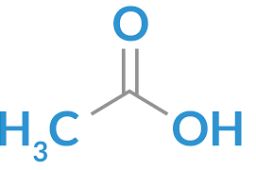
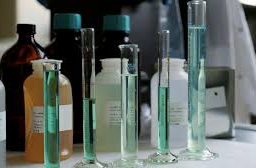
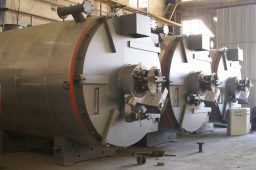
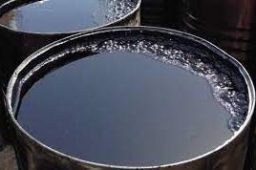






برای نوشتن دیدگاه باید وارد بشوید.